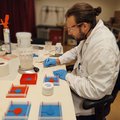 OK folks, welcome to the Hack Chat. I'm Dan and I'll be the moderator today for our talk with Oxikit about open-source oxygen concentrators.
OK folks, welcome to the Hack Chat. I'm Dan and I'll be the moderator today for our talk with Oxikit about open-source oxygen concentrators.
Things are going to work a bit differently today: our guest is Maher Daoudi, but he's in transit today, so I'm on the phone with him. I'll relay questions to him and type in the answers, so his answers will appear under my handle. It'll be a bit weird, but I think it'll work -- just have patience as we work through the process.
 Hi
Hi
 Hi all
Hi all
 Hi all!
Hi all!
 I'm going to call Maher now, talk amongst yourselves for a minute or two, and perhaps queue up some questions
I'm going to call Maher now, talk amongst yourselves for a minute or two, and perhaps queue up some questions
![]() Hello.
Hello.
 I looked into this kit, due to my desire to help out in India. and was thinking of doing one kit as trial
I looked into this kit, due to my desire to help out in India. and was thinking of doing one kit as trial
 I have seen the you tube videos a bit, and I think I get the basic hang of the system.
I have seen the you tube videos a bit, and I think I get the basic hang of the system.
![]() I'm curious about the Cost / Value analysis between the oxikit and commercially available units.
I'm curious about the Cost / Value analysis between the oxikit and commercially available units.
 My main question is around scalability of the system and cost/value as Robert says
My main question is around scalability of the system and cost/value as Robert says
![]() Oxygen sensors are insanely expensive and the electrochemical ones wear down. Are there ways to assess the approximate oxygen purity by other means (thermal conductivity, breakdown voltage...)?
Oxygen sensors are insanely expensive and the electrochemical ones wear down. Are there ways to assess the approximate oxygen purity by other means (thermal conductivity, breakdown voltage...)?
 A little about Maher: he's a serial entrepreneur, set up a number of international platforms, and now he's turning his attention to making sure people can keep breathing.
A little about Maher: he's a serial entrepreneur, set up a number of international platforms, and now he's turning his attention to making sure people can keep breathing.
 How much can we scale up
How much can we scale up
 For example can we go to 50LPM, with just replacement of valves and compressor?
For example can we go to 50LPM, with just replacement of valves and compressor?
![]() Another bottleneck is the zeolites for the pressure swing absorption. Are there ways to cut cost?
Another bottleneck is the zeolites for the pressure swing absorption. Are there ways to cut cost?
 Maher also set up Pillar Tribe, a coalition of doctors and scientists that serves as a central platform with Oxikit as the core product
Maher also set up Pillar Tribe, a coalition of doctors and scientists that serves as a central platform with Oxikit as the core product
 What would the cost be if we did that? Current cost of the 5L unit is too high compared to commercial units
What would the cost be if we did that? Current cost of the 5L unit is too high compared to commercial units
![]() @ramamurthyrajesh1 You'll have to also increase the volume of the zeolite columns. These are the critical part.
@ramamurthyrajesh1 You'll have to also increase the volume of the zeolite columns. These are the critical part.
 @Adi Oltean is here too from Pillar Tribe. Hi Adi, can you chip in here?
@Adi Oltean is here too from Pillar Tribe. Hi Adi, can you chip in here?
 Sure
Sure
 hi all, yes
hi all, yes
 Got that. Yes, so
Got that. Yes, so
 the easiest way to scale the system is scale-out (not scale-up). Just put more concentrators in parallel
the easiest way to scale the system is scale-out (not scale-up). Just put more concentrators in parallel
 But that makes the cost n * cost of 1 unit
But that makes the cost n * cost of 1 unit
![]() Special zeolites with silver treatment are used for gas separation. Can there be something less expensive that's still Good Enough?
Special zeolites with silver treatment are used for gas separation. Can there be something less expensive that's still Good Enough?
 As with any open source concentrator, if you want to make it bigger you need to increase the size of the zeolite tanks and the width of the piping. That also changes the required timings so it will mean re-testing it
As with any open source concentrator, if you want to make it bigger you need to increase the size of the zeolite tanks and the width of the piping. That also changes the required timings so it will mean re-testing it
 current cost is $1K for 5L
current cost is $1K for 5L
 @Thomas Shaddack - there are docs in the Oxikit project on Hackaday.io on alternate sensors:
@Thomas Shaddack - there are docs in the Oxikit project on Hackaday.io on alternate sensors:

https://hackaday.io/project/178334/files
OxiKit Oxygen Concentrator
High Flow Oxygen Concentrator 15 LPM at 90%+ Concentrated o2 https://oxikit.com
 Look for three files starting with "o2analyser..."
Look for three files starting with "o2analyser..."
 >>> But that makes the cost n * cost of 1 unit
>>> But that makes the cost n * cost of 1 unit
Yes, even scale-up requires more zeolite and a bigger compressor so either way it's a linear scaling.
 How are the commercial systems able to cost 1/2 the cost we have?
How are the commercial systems able to cost 1/2 the cost we have?
 Is that because of combining all the tubing inside?
Is that because of combining all the tubing inside?
![]() Hence my oxygen sensor question. If we measure the output gases, the unit could self-calibrate.
Hence my oxygen sensor question. If we measure the output gases, the unit could self-calibrate.
![]() ...and yes, oxikit uses the degrading-over-time electrochemical sensors that cost big money. :( :( I'd prefer something more durable like NDIR.
...and yes, oxikit uses the degrading-over-time electrochemical sensors that cost big money. :( :( I'd prefer something more durable like NDIR.
 @Adi, do you have any more resources for @Thomas Shaddack for oxygen sensors?
@Adi, do you have any more resources for @Thomas Shaddack for oxygen sensors?
 yes
yes
 generally ultrasonic O2 sensors are much cheaper
generally ultrasonic O2 sensors are much cheaper
 and they don't degrade over time
and they don't degrade over time
 they do need to be calibrated though for the particular range of gas mixtures produced by the concentrator
they do need to be calibrated though for the particular range of gas mixtures produced by the concentrator
![]() Never heard about those! But makes sense.
Never heard about those! But makes sense.
 sensors are needed only if need closed loop control. why need O2 sensors on active unit?
sensors are needed only if need closed loop control. why need O2 sensors on active unit?
 @ramamurthyrajesh1 - Most commercial systems don't have the output Oxikit has. They often have 90% purity only at a lower flow rate, while Oxikit does 90% over the full flow rate range
@ramamurthyrajesh1 - Most commercial systems don't have the output Oxikit has. They often have 90% purity only at a lower flow rate, while Oxikit does 90% over the full flow rate range
![]() Would also work for oxygen/hydrogen production by electrolysis. That's another option for oxygen sourcing, maybe we wouldn't even need the overly expensive nafion membranes and ordinary microporous polyolefin salvaged from dead Li-ion cells could do the job. (Worked on testtube-sized setup.) The inevitable cross-contamination then can be handled by catalytic recombination and the extra humidity is actually a bonus for medical gas. (I sniffed around this for pure hydrogen production but it works on both ends.)
Would also work for oxygen/hydrogen production by electrolysis. That's another option for oxygen sourcing, maybe we wouldn't even need the overly expensive nafion membranes and ordinary microporous polyolefin salvaged from dead Li-ion cells could do the job. (Worked on testtube-sized setup.) The inevitable cross-contamination then can be handled by catalytic recombination and the extra humidity is actually a bonus for medical gas. (I sniffed around this for pure hydrogen production but it works on both ends.)
 @ramamurthyrajesh1 - Because Oxikit is looking to close the loop with a pulse oximeter on the patient. Also looking at adding a predictive algorithm that's the same as the one used on ARDS patients.
@ramamurthyrajesh1 - Because Oxikit is looking to close the loop with a pulse oximeter on the patient. Also looking at adding a predictive algorithm that's the same as the one used on ARDS patients.
 electrolysis is also a well-known technique for oxygen (and hydrogen) production. The problem is that it consumes an insane amount of electricity given that the process isn't very efficient (most energy wasted as heat, actually). It is also very slow. You need a very sizeable system to produce oxygen at the rate of 15 lpm
electrolysis is also a well-known technique for oxygen (and hydrogen) production. The problem is that it consumes an insane amount of electricity given that the process isn't very efficient (most energy wasted as heat, actually). It is also very slow. You need a very sizeable system to produce oxygen at the rate of 15 lpm
![]() Related subject. Cheap COVID ventilator. It is much safer to use and it might actually be more effective. If there are people in India who have the skills to build this, please message me.
Related subject. Cheap COVID ventilator. It is much safer to use and it might actually be more effective. If there are people in India who have the skills to build this, please message me.
Video 1:40. https://www.youtube.com/watch?
OnShape CAD design.
https://cad.onshape.com/documents/bec676327d62113c31e2710f/w/302023044e890cc67d352496/e/84643bc8f1be17e76199175ev=nFWgGSywmPw
![]()
 Also, sensors allow for self-calibration too
Also, sensors allow for self-calibration too
 @Hank DeBey - i'd like to learn and then transfer skills
@Hank DeBey - i'd like to learn and then transfer skills
 is all this chat getting captured somewhere ?
is all this chat getting captured somewhere ?
 @Dan Maloney any plans for uploading data from oxikit to cloud for metrics?
@Dan Maloney any plans for uploading data from oxikit to cloud for metrics?
 so we can see the notes after the meeting ?
so we can see the notes after the meeting ?
 Yes, chat transcript will be available after the chat
Yes, chat transcript will be available after the chat
![]() @Hank DeBey non-steampunk-like "steel lung"?
@Hank DeBey non-steampunk-like "steel lung"?
 @Hank DeBey - thank you
@Hank DeBey - thank you
 And Maher agrees -- electrolysis is no bueno, could be very dangerous. Oxygen + hydrogen == space shuttle engines
And Maher agrees -- electrolysis is no bueno, could be very dangerous. Oxygen + hydrogen == space shuttle engines
 Fun in a different direction...
Fun in a different direction...
![]() That's why hydrogen has to be burned off immediately, without allowing accumulation of any significant amount. In a burner or on a catalyst.
That's why hydrogen has to be burned off immediately, without allowing accumulation of any significant amount. In a burner or on a catalyst.
 What are the consumable parts that we should consider to replace in long run?
What are the consumable parts that we should consider to replace in long run?
![]() (Crazy thought, likely impractical. Feed it into a fuel cell to recover some of the energy.)
(Crazy thought, likely impractical. Feed it into a fuel cell to recover some of the energy.)
![]() @Thomas Shaddack that would produce even more heat than electrolysis alone
@Thomas Shaddack that would produce even more heat than electrolysis alone
 Also timeline for different parts? considering its continuous use?
Also timeline for different parts? considering its continuous use?
 @dexteralpha - Yes. They've been working with Arduino to make some IoT stuff happen. Also working with global telehealth services to make online metrics and monitoring work.
@dexteralpha - Yes. They've been working with Arduino to make some IoT stuff happen. Also working with global telehealth services to make online metrics and monitoring work.
![]() If you would directly couple the oxygen generator with a patient support system, I would consider it a medical device. Regularly nightmare in Europe.
If you would directly couple the oxygen generator with a patient support system, I would consider it a medical device. Regularly nightmare in Europe.
 @Mrityunjai Kumar -Typically, system can run 24/7 with oilless continuous duty compressor. Zeolite lasts about a year before being swapped out.
@Mrityunjai Kumar -Typically, system can run 24/7 with oilless continuous duty compressor. Zeolite lasts about a year before being swapped out.
@Adi -- any other compressor parts need to be replaced from time to time?
 I believe the compressor can be serviced, but it generally lasts a few thousand hours depending on the model
I believe the compressor can be serviced, but it generally lasts a few thousand hours depending on the model
 The compressor is the most critical part of the system. If it fails it can be swapped out
The compressor is the most critical part of the system. If it fails it can be swapped out
![]() What are the skills required to start working on Oxygen Concentrator?
What are the skills required to start working on Oxygen Concentrator?
 @H Fehr - Actually, European regulators are very interested in Oxikit
@H Fehr - Actually, European regulators are very interested in Oxikit
 On behalf of @Peter Walsh who isn't here I repost the following question (too which they really want answer) :
On behalf of @Peter Walsh who isn't here I repost the following question (too which they really want answer) :
I’m about to start a project that pipes oxygen into a reaction setup (that I built), and I’d like to learn the fundamentals of oxygen hacking. I hear that “The Oxygen Hacker’s Companion” is the go-to reference for this, but the book is no longer purchasable (sent a check awhile ago, no response) and it’s not available anywhere.
Does anyone have a good source for learning about oxygen plumbing from the ground up? Something not sky-high technical, but full of down-to-earth suggestions and examples, sort of like the Radio Amateur’s Handbook, but for gas plumbing?
(Alternately – is anyone willing to send me a photocopy of the Oxygen Hacker’s companion? I’d be happy to pay copier fees and postage, and I’ve already sent a check to the author. Contact me on .IO if interested https://hackaday.io/PWalsh)
![]() It should be supported by an organisation or else any individual can make it ?
It should be supported by an organisation or else any individual can make it ?
 >>> I hear that “The Oxygen Hacker’s Companion” is the go-to reference for this, but the book is no longer purchasable (sent a check awhile ago, no response) and it’s not available anywhere.
>>> I hear that “The Oxygen Hacker’s Companion” is the go-to reference for this, but the book is no longer purchasable (sent a check awhile ago, no response) and it’s not available anywhere.
I was looking for that book for quite some time as well
 @Inne - Got to Oxikit's YouTube channel, there's a video there that explains step-by=step how O2 concentrators work and how to built every component
@Inne - Got to Oxikit's YouTube channel, there's a video there that explains step-by=step how O2 concentrators work and how to built every component

https://www.youtube.com/channel/UCHh-VoQp4_IM_m6r_40oJQQ
OxiKit
Share your videos with friends, family, and the world
![]() Thanks. ;)
Thanks. ;)
 @inne - also check out the glass works/lamp work community. They regularly repurpose second-hand concentrators from ebay/Craigslist
@inne - also check out the glass works/lamp work community. They regularly repurpose second-hand concentrators from ebay/Craigslist
 I think it's more specifically about good practices when working with highly concentrated oxygen (as a reference guide) is that also on there??
I think it's more specifically about good practices when working with highly concentrated oxygen (as a reference guide) is that also on there??
![]() @Inne One of the problems with oxygen is its tendency to make even poorly flammable stuff flammable, and the flammable stuff extra-flammable. Otherwise it's a friendly gas, nontoxic and nonstinky. And yes, I second the approach of the glassworking torch users.
@Inne One of the problems with oxygen is its tendency to make even poorly flammable stuff flammable, and the flammable stuff extra-flammable. Otherwise it's a friendly gas, nontoxic and nonstinky. And yes, I second the approach of the glassworking torch users.
 Oxikit also has designs for modular concentrators, scale up or down as needed. Can go up to 100 lpm or more at 90>#/span###
Oxikit also has designs for modular concentrators, scale up or down as needed. Can go up to 100 lpm or more at 90>#/span###
 >>> I think it's more specifically about good practices when working with highly concentrated oxygen (as a reference guide) is that also on there??
>>> I think it's more specifically about good practices when working with highly concentrated oxygen (as a reference guide) is that also on there??
1) Safety first. Make sure you work with approved plastic parts. Some plastics catch fire quite easily. Generally for medical purpose you should use tubing and consumables already approved for use with oxygen
2) Be careful about any sources of fire. Even sparks from electrostatic discharge can start a fire
 @Dan Maloney Hi, thanks for taking the time to do this. I'm actually working with some folks and we're trying to redesign the current o2 concentrator setup (coincidentally O2 concentrators became important in O2 therapy for COVID patients last year). I've got a couple of Qs I was hoping for some leads with:
@Dan Maloney Hi, thanks for taking the time to do this. I'm actually working with some folks and we're trying to redesign the current o2 concentrator setup (coincidentally O2 concentrators became important in O2 therapy for COVID patients last year). I've got a couple of Qs I was hoping for some leads with:
1. What are your views on increasing the number of inlets into the zeolite columns to speed up the nitrogen adsorption process, possibly reduce the cycle times?
2. Where I'm at (India), continuous power input is very unlikely. Brownouts and total power loss is very common. Do you think it's possible to integrate the Oxikit with a tank to continuously fill up on the side (or would that destroy the compressor faster from the pressure required? Any alternatives?)
3. For patients who require oxygen (in a post COVID ravaged world), pulse delivery of O2 is common to reduce the amount of oxygen that is being wasted. Any thoughts on integrating this with a device that leverages the 'shape signal' method like ventilators today to time oxygen release better?
4. I was under the impression that Zeolite contamination is one of the biggest issues with the current concentrators? Are there any feasible alternatives (asking for another project for the client) for O2 concentration or less niggly solutions (again not for oxikit, just regarding concentrators in general)
Thanks for your time :)
 Maher asks that we stick to "how-to" type questions rather than regulatory or clinical question, FYI
Maher asks that we stick to "how-to" type questions rather than regulatory or clinical question, FYI
![]() To put a bit more water in your wine, might a low tech solution to improve the inhalators used in the field be more effective in the total effect by reducing oxygen consumption?
To put a bit more water in your wine, might a low tech solution to improve the inhalators used in the field be more effective in the total effect by reducing oxygen consumption?
 @Rithwik Jayasimha - There are three critical timing points, you can find them in the Oxikit code. They can be adjusted to change the overall cycle time, which will affect the efficiency/volume output
@Rithwik Jayasimha - There are three critical timing points, you can find them in the Oxikit code. They can be adjusted to change the overall cycle time, which will affect the efficiency/volume output
 I just got off the phone with the person who sells the "oxygen hacker's companion", and he's still in business but not selling that book, considering throwing it open source, and otherwise looking for a good way to sell it. We had a good talk and I gave him some ideas and suggestions, and maybe he will start selling again. (I pointed out that 2 books are currently up for bid on eBay for $200... maybe that will get him interested again.)
I just got off the phone with the person who sells the "oxygen hacker's companion", and he's still in business but not selling that book, considering throwing it open source, and otherwise looking for a good way to sell it. We had a good talk and I gave him some ideas and suggestions, and maybe he will start selling again. (I pointed out that 2 books are currently up for bid on eBay for $200... maybe that will get him interested again.)
Otherwise, I found 1 copy of the book in 1 library worldwide, it's in the library at Woods Hole MA, and that's not unreasonably far for me to drive down to read it so that's the backup plan. (Closed until the end of Covid, so maybe in a month or two.)
 @Rithwik Jayasimha - The surge tank in the system pretty much does just that. You can scale up the size of that tank to be more of a storage tank for brownouts.
@Rithwik Jayasimha - The surge tank in the system pretty much does just that. You can scale up the size of that tank to be more of a storage tank for brownouts.
 @Rithwik Jayasimha - to expand on the surge tank idea, a common usage worldwide of oxygen concentrators is to take the oxygen output of the concentrator, compress it and use the high-pressure O2 to fill out oxygen tanks. However this requires a special oil-less compressor that can be an expensive component. You can acquire it second-hand for a few hundred $
@Rithwik Jayasimha - to expand on the surge tank idea, a common usage worldwide of oxygen concentrators is to take the oxygen output of the concentrator, compress it and use the high-pressure O2 to fill out oxygen tanks. However this requires a special oil-less compressor that can be an expensive component. You can acquire it second-hand for a few hundred $
 @Rithwik Jayasimha - Oxikit is working with Lifemech.org on an open-source ventilator, sent them an Oxikit that they integrated with their ventilator
@Rithwik Jayasimha - Oxikit is working with Lifemech.org on an open-source ventilator, sent them an Oxikit that they integrated with their ventilator
 Maher concurs, filling tanks is kind of like the dive tank industry.
Maher concurs, filling tanks is kind of like the dive tank industry.
 yeah. The difficulty there is that you need to use an special-purpose compressor that is oxygen compatible (oxygen destroys typical sealing/gaskets in regular compressors). This oxygen-compatible compressor is not a piece that I would recommend DIY approach, needs to be acquired commercially
yeah. The difficulty there is that you need to use an special-purpose compressor that is oxygen compatible (oxygen destroys typical sealing/gaskets in regular compressors). This oxygen-compatible compressor is not a piece that I would recommend DIY approach, needs to be acquired commercially
 @Rithwik Jayasimha - The big issue is humidity and keeping it out of the zeolite. Control that and your good to go. Storage is a special problem too -- when not in use, humidity can enter the sieves. You have to make sure that air can't enter when not in use.
@Rithwik Jayasimha - The big issue is humidity and keeping it out of the zeolite. Control that and your good to go. Storage is a special problem too -- when not in use, humidity can enter the sieves. You have to make sure that air can't enter when not in use.
 @Adi Oltean yeah that was the general idea I got too, thanks :)
@Adi Oltean yeah that was the general idea I got too, thanks :)
 Thanks Dan. Any new/hacky alternatives to the PSA system today?
Thanks Dan. Any new/hacky alternatives to the PSA system today?
 Perhaps this has already been covered but is there a way to regenerate contaminated zeolite, ovenizing it etc.
Perhaps this has already been covered but is there a way to regenerate contaminated zeolite, ovenizing it etc.
 Maher says: makers and tinkerers, if you're thinking about fiddling with the Oxikit design, PLEASE try building one by the book first. He's done a lot of optimization, burned out a lot of pumps and parts. Get it working first, then start tinkering on top of that.
Maher says: makers and tinkerers, if you're thinking about fiddling with the Oxikit design, PLEASE try building one by the book first. He's done a lot of optimization, burned out a lot of pumps and parts. Get it working first, then start tinkering on top of that.
![]() @kjansky1 - you can regenerate the zeolite by heating it in an oven. Make sure that you convect the air above the zeolite to ensure that the released moisture won't go back into the zeolite at the end of the regeneration cycle
@kjansky1 - you can regenerate the zeolite by heating it in an oven. Make sure that you convect the air above the zeolite to ensure that the released moisture won't go back into the zeolite at the end of the regeneration cycle
https://www.sigmaaldrich.com/chemistry/chemical-synthesis/learning-center/technical-bulletins/al-1430/molecular-sieves.html
 @Adi - can you field @kjansky1 question?
@Adi - can you field @kjansky1 question?
 Thanks!
Thanks!
 From a patent online: "The concentrator can be regenerated by decreasing the pressure to release the adsorbed nitrogen. " Perhaps put them in a vacuum chamber with gentle heating?
From a patent online: "The concentrator can be regenerated by decreasing the pressure to release the adsorbed nitrogen. " Perhaps put them in a vacuum chamber with gentle heating?
https://www.ncbi.nlm.nih.gov/pmc/articles/PMC5575677/
 Any approximate temperature recommended.
Any approximate temperature recommended.
![]() @Peter Walsh - yes, there are techniques of regeneration under vacuum
@Peter Walsh - yes, there are techniques of regeneration under vacuum
@kjansky1 - see the Sigma-Aldrich paper above. Generally 300C ... 315C for a few hours
 Another critical thing: there's sodium- and lithium-based zeolite. Lithium is twice as efficient but costs 5-10 times more, and harder to source. You can still hit the 90% purity with sodium, by recycling the enriched air to run it through a second process.
Another critical thing: there's sodium- and lithium-based zeolite. Lithium is twice as efficient but costs 5-10 times more, and harder to source. You can still hit the 90% purity with sodium, by recycling the enriched air to run it through a second process.
 Which is what Oxikit does ;-)
Which is what Oxikit does ;-)
![]() Is Zeolite readily available perhaps sold under a brand name?
Is Zeolite readily available perhaps sold under a brand name?
 @kjansky1: see table midway down this page: https://www.sigmaaldrich.com/chemistry/chemical-synthesis/learning-center/technical-bulletins/al-1430/molecular-sieves.html
@kjansky1: see table midway down this page: https://www.sigmaaldrich.com/chemistry/chemical-synthesis/learning-center/technical-bulletins/al-1430/molecular-sieves.html
 Overall, it's way cheaper in time and energy to just get new zeolite than trying to refresh used zeolite
Overall, it's way cheaper in time and energy to just get new zeolite than trying to refresh used zeolite
 From Maher: Also, make sure you're using Schedule 40 or above PVC pipe -- handles 200+ PSI. Also, put a pressure relief valve prior to going into the sieve, set to 50PSI. You don't wan to overpressurize the sieves!
From Maher: Also, make sure you're using Schedule 40 or above PVC pipe -- handles 200+ PSI. Also, put a pressure relief valve prior to going into the sieve, set to 50PSI. You don't wan to overpressurize the sieves!
 Thanks the link gives temp for regeneration, if you have experience with reutilizing the regenerated zeolite does it have a loss in N2 adsorption capacity with reuse.
Thanks the link gives temp for regeneration, if you have experience with reutilizing the regenerated zeolite does it have a loss in N2 adsorption capacity with reuse.
![]() Regarding storage, would disconnecting the sieves, and using a small vacuum pump and some appropriately sized push to connect plugs work to keep air out?
Regarding storage, would disconnecting the sieves, and using a small vacuum pump and some appropriately sized push to connect plugs work to keep air out?
![]() On zeolite regeneration, I would also recommend checkung out forums where hobbyists in the glass works/bead works/lamp work hang out. Regeneration of zeolite is a common technique typically employed iun reconditioning used oxygen generators and injecting life into them. All is needed is a kitchen oven and a fan for air recirculation (in front of the slightly opened oven door) .
On zeolite regeneration, I would also recommend checkung out forums where hobbyists in the glass works/bead works/lamp work hang out. Regeneration of zeolite is a common technique typically employed iun reconditioning used oxygen generators and injecting life into them. All is needed is a kitchen oven and a fan for air recirculation (in front of the slightly opened oven door) .
 Also from Maher: most compressors are made to operate at high pressure, low volume. To get 15 lpm of O2, you need to get one that at 2 bar (40 PSI) can produce at least 160 lpm.
Also from Maher: most compressors are made to operate at high pressure, low volume. To get 15 lpm of O2, you need to get one that at 2 bar (40 PSI) can produce at least 160 lpm.
![]() Or pressurize the cylinders with dry air, or nitrogen, or CO2..., to prevent leaks towards the inside?
Or pressurize the cylinders with dry air, or nitrogen, or CO2..., to prevent leaks towards the inside?
![]() >>> Thanks the link gives temp for regeneration, if you have experience with reutilizing the regenerated zeolite does it have a loss in N2 adsorption capacity with reuse.
>>> Thanks the link gives temp for regeneration, if you have experience with reutilizing the regenerated zeolite does it have a loss in N2 adsorption capacity with reuse.
IIRC there is some efficiency % loss over time even after reconditioning. Reconditioned zeolite doesn't have quite the same performance as new zeolite
![]() Is there nothing that Amazon does not sell? I have found Zeolite Clinoptilolite is that what I need?
Is there nothing that Amazon does not sell? I have found Zeolite Clinoptilolite is that what I need?
 Also on the compressor: before it goes into the patient, the O2 needs to be humidified. So you need to provide a little bubbler that the O2 flows through before going to the mask. Very common in hospitals etc.
Also on the compressor: before it goes into the patient, the O2 needs to be humidified. So you need to provide a little bubbler that the O2 flows through before going to the mask. Very common in hospitals etc.
![]() Even cat litter is zeolite based. So not all amazon zeolites may be the right ones...
Even cat litter is zeolite based. So not all amazon zeolites may be the right ones...
 @Simon - No, there are many different zeolites. You need 13x, 0.5 mm or lower mesh size. And sodium-based, too.
@Simon - No, there are many different zeolites. You need 13x, 0.5 mm or lower mesh size. And sodium-based, too.
 Yeah, you don't want to use cat litter. Even unscented!
Yeah, you don't want to use cat litter. Even unscented!
![]() >> Is there nothing that Amazon does not sell? I have found Zeolite Clinoptilolite is that what I need?
>> Is there nothing that Amazon does not sell? I have found Zeolite Clinoptilolite is that what I need?
No. You need specifically 13X 20-40 zeolite. 13X is the particular zeolite required, 20-40 is the bead size (0.4 mmm ... 0.8 mm)
![]() this is what's called "medical-grade zeolite"
this is what's called "medical-grade zeolite"
 Contact info for Maher:
Contact info for Maher:

http://www.linkedin.com/in/maherdaoudi
Maher Daoudi - Chief Executive Officer - Shield Mission | LinkedIn
‼️🦠 Our Covid BREAKTHROUGH: DIY High Flow o2 Concentrator WITH iOT Hub & Remote Telehealth Monitoring Platform - Supported by 250+ Fortune 100 executives, Chief Medical Directors, MedTech Entrepreneurs, Engineers & Scientists working behind the scenes in a private WhatsApp group.

Shield Mission
Reducing Patient Progression to Critical Stages During fearful surges of the Coronavirus, hospitals struggle to admit and care for critically ill patients. There is a great need to free up hospitals to attend to more severe and critical cases, while ensuring mild and asymptomatic cases remain controlled and manageable.

Pillar Tribe | A curated community of C-Level leaders & Expert Advisers
Pillar Tribe is a private and highly curated group of 250 Fortune 100 Executives, Entrepreneurs, Engineers, Scientists collaborating together on various projects to help our communities. #ShieldMission is the current collaborative project we are working on. We work in a private WhatsApp channel. The info graphic bellow describes our goal.
![]() 5X is another sodium-based zeolite that may work but not as efficient. there is also LiX (lithium-based) and AgX (silver-based) but much more expensive
5X is another sodium-based zeolite that may work but not as efficient. there is also LiX (lithium-based) and AgX (silver-based) but much more expensive
 Also, jump into the Telegram channel to chat about Oxikit:
Also, jump into the Telegram channel to chat about Oxikit:

https://t.me/joinchat/IfA7oxo3JNYqlvmRTLljJg
Pillar Tribe
Share Join link: https://t.me/joinchat/U6-Wgd7WBvNMuWMm Leaders & Innovators Think Tank. When you join, introduce yourself, what you do, your background and share your LinkedIn profile to connect with other members. Share knowledge, ask for help and help You are invited to the group Pillar Tribe. Click above to join.
 OK, we're out of time and my fingers are tired! I want to thank Maher and Adi for coming on today, and all of you for your questions and patience with the odd format. Thanks!
OK, we're out of time and my fingers are tired! I want to thank Maher and Adi for coming on today, and all of you for your questions and patience with the odd format. Thanks!
 Next week, we're staying on a somewhat related topic:
Next week, we're staying on a somewhat related topic:

https://hackaday.io/event/179265-embedded-rust-hack-chat
Embedded Rust Hack Chat
James Munns will host the Hack Chat on Wednesday, May 12 at noon Pacific. Time zones got you down? Try our handy time zone converter. Programming languages, like fashion, are very much a matter of personal taste.
 Rust? Oxygen? See what I did there?
Rust? Oxygen? See what I did there?
![]() Thank you very much for answering questions.
Thank you very much for answering questions.
 haha
haha
![]() Rust? So we got the car rot, will there be also a stick?
Rust? So we got the car rot, will there be also a stick?
 Transcript coming up -- gimme a few minutes to shake out my fingers
Transcript coming up -- gimme a few minutes to shake out my fingers
 Dan Maloney
Dan Maloney


Discussions
Become a Hackaday.io Member
Create an account to leave a comment. Already have an account? Log In.